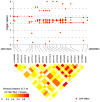Evidence of gene-environment interaction for the IRF6 gene and maternal multivitamin supplementation in controlling the risk of cleft lip with/without cleft palate
- PMID: 20652317
- PMCID: PMC2956506
- DOI: 10.1007/s00439-010-0863-y
Evidence of gene-environment interaction for the IRF6 gene and maternal multivitamin supplementation in controlling the risk of cleft lip with/without cleft palate
Abstract
Although multiple genes have been identified as genetic risk factors for isolated, non-syndromic cleft lip with/without cleft palate (CL/P), a complex and heterogeneous birth defect, interferon regulatory factor 6 gene (IRF6) is one of the best documented genetic risk factors. In this study, we tested for association between markers in IRF6 and CL/P in 326 Chinese case-parent trios, considering gene-environment interaction for two common maternal exposures, and parent-of-origin effects. CL/P case-parent trios from three sites in mainland China and Taiwan were genotyped for 22 single nucleotide polymorphisms (SNPs) in IRF6. The transmission disequilibrium test was used to test for marginal effects of individual SNPs. We used PBAT to screen the SNPs and haplotypes for gene-environment (G×E) interaction and conditional logistic regression models to quantify effect sizes for SNP-environment interaction. After Bonferroni correction, 14 SNPs showed statistically significant association with CL/P. Evidence of G×E interaction was found for both maternal exposures, multivitamin supplementation and environmental tobacco smoke (ETS). Two SNPs showed evidence of interaction with multivitamin supplementation in conditional logistic regression models (rs2076153 nominal P=0.019, rs17015218 nominal P=0.012). In addition, rs1044516 yielded evidence for interaction with maternal ETS (nominal P=0.041). Haplotype analysis using PBAT also suggested interaction between SNPs in IRF6 and both multivitamin supplementation and ETS. However, no evidence for maternal genotypic effects or significant parent-of-origin effects was seen in these data. These results suggest IRF6 gene may influence risk of CL/P through interaction with multivitamin supplementation and ETS in the Chinese population.
Figures



Similar articles
-
Haplotype and Haplotype-Environment Interaction Analysis Revealed Roles of SPRY2 for NSCL/P among Chinese Populations.Int J Environ Res Public Health. 2019 Feb 15;16(4):557. doi: 10.3390/ijerph16040557. Int J Environ Res Public Health. 2019. PMID: 30769929 Free PMC article.
-
Joint testing of genotypic and gene-environment interaction identified novel association for BMP4 with non-syndromic CL/P in an Asian population using data from an International Cleft Consortium.PLoS One. 2014 Oct 10;9(10):e109038. doi: 10.1371/journal.pone.0109038. eCollection 2014. PLoS One. 2014. PMID: 25303326 Free PMC article.
-
Evidence of gene-environment interaction for the RUNX2 gene and environmental tobacco smoke in controlling the risk of cleft lip with/without cleft palate.Birth Defects Res A Clin Mol Teratol. 2012 Feb;94(2):76-83. doi: 10.1002/bdra.22885. Epub 2012 Jan 12. Birth Defects Res A Clin Mol Teratol. 2012. PMID: 22241686 Free PMC article.
-
Evidence that TGFA influences risk to cleft lip with/without cleft palate through unconventional genetic mechanisms.Hum Genet. 2009 Sep;126(3):385-94. doi: 10.1007/s00439-009-0680-3. Epub 2009 May 15. Hum Genet. 2009. PMID: 19444471 Free PMC article.
-
Association between the IRF6 rs2235371 polymorphism and the risk of nonsyndromic cleft lip with or without cleft palate in Chinese Han populations: A meta-analysis.Arch Oral Biol. 2017 Dec;84:161-168. doi: 10.1016/j.archoralbio.2017.09.032. Epub 2017 Oct 2. Arch Oral Biol. 2017. PMID: 29017114 Review.
Cited by
-
Toward an orofacial gene regulatory network.Dev Dyn. 2016 Mar;245(3):220-32. doi: 10.1002/dvdy.24341. Epub 2015 Sep 17. Dev Dyn. 2016. PMID: 26332872 Free PMC article. Review.
-
Translational strategies to uncover the etiology of congenital anomalies of the kidney and urinary tract.Pediatr Nephrol. 2025 Mar;40(3):685-699. doi: 10.1007/s00467-024-06479-2. Epub 2024 Oct 7. Pediatr Nephrol. 2025. PMID: 39373868 Free PMC article. Review.
-
A comparison of DNA methylation in newborn blood samples from infants with and without orofacial clefts.Clin Epigenetics. 2019 Mar 4;11(1):40. doi: 10.1186/s13148-019-0638-9. Clin Epigenetics. 2019. PMID: 30832715 Free PMC article.
-
Radiographic Study of the Prevalence and Distribution of Hypodontia Associated with Unilateral and Bilateral Clef Lip and Palate in a Hungarian Population.Med Sci Monit. 2016 Oct 21;22:3868-3885. doi: 10.12659/msm.897957. Med Sci Monit. 2016. PMID: 27767023 Free PMC article.
-
Haplotype and Haplotype-Environment Interaction Analysis Revealed Roles of SPRY2 for NSCL/P among Chinese Populations.Int J Environ Res Public Health. 2019 Feb 15;16(4):557. doi: 10.3390/ijerph16040557. Int J Environ Res Public Health. 2019. PMID: 30769929 Free PMC article.
References
-
- Barret JC, Fry B, Maller J, Daly MJ. Haploview: analysis and visualization of LD and haplotype maps. Bioinformatics. 2005;21:263–265. - PubMed
-
- Birnbaum S, Reutter H, Lauster C, Scheer M, Schmidt G, Saffar M, Martini M, Hemprich A, Henschke H, Kramer FJ, Mangold E. Mutation screening in the IRF6-gene in patients with apparently nonsyndromic orofacial clefts and a positive family history suggestive of autosomal-dominant inheritance. Am J Med Genet A. 2008;146A:787–790. - PubMed
-
- Blanton SH, Cortez A, Stal S, Mulliken JB, Finnell RH, Hecht JT. Variation in IRF6 contributes to nonsyndromic cleft lip and palate. Am J Med Genet A. 2005;137A:259–262. - PubMed
Publication types
MeSH terms
Substances
Grants and funding
LinkOut - more resources
Full Text Sources
Medical
Miscellaneous

